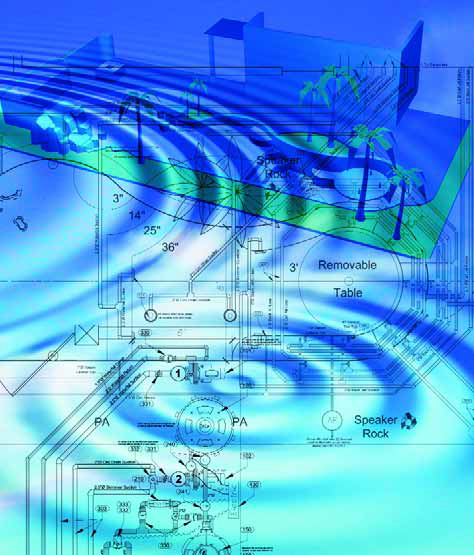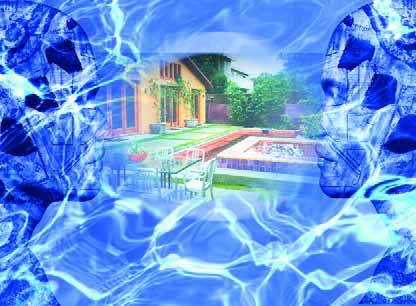Professional Watershaping
Why isn't the appropriate use of water a defining, central component in the education of landscape architects? That question has rattled around in my head for a long, long time, basically because it has no adequate or satisfactory answer. I'm a trained landscape architect and, as luck would have it, for nearly 20 years I've had one foot in the pool industry and the other in landscape architecture - and I've always felt like a rare beast moving back and forth between two entirely separate worlds. As I see it, this lack of affinity between these water-related industries has been a limiting factor in the advancement of the watershaping trades. For me, the lack of connection has always seemed nonsensical when it hasn't seemed tragic. As a watershaper, a big part of my work in recent years has been seeking ways to combine the best of both worlds and share what I know with university-level students in landscape architecture departments - students whose chairs I occupied some years ago and who still stand a good chance of graduating without ever having been taught anything at all about how water can
When I sit down with clients for our first face-to-face meeting, we discuss a range of issues that will guide me when I return to my studio and get down to designing a watershape and surrounding areas for them. We'll talk about colors, materials, the location of the pool, their preferences in art, the way they entertain and, perhaps most important of all, how they plan to use their backyard and swimming pool. Let's focus on that last point: When we talk about how a pool is going to be used, what I really want to know is how it will be used on a daily or weekly basis (for swimming, exercise, play or simply as a visual), not how it's going to be used once or twice each year when they throw a big pool party. My thought is that these clients will
When I sit down with clients for our first face-to-face meeting, we discuss a range of issues that will guide me when I return to my studio and get down to designing a watershape and surrounding areas for them. We'll talk about colors, materials, the location of the pool, their preferences in art, the way they entertain and, perhaps most important of all, how they plan to use their backyard and swimming pool. Let's focus on that last point: When we talk about how a pool is going to be used, what I really want to know is how it will be used on a daily or weekly basis (for swimming, exercise, play or simply as a visual), not how it's going to be used once or twice each year when they throw a big pool party. My thought is that these clients will
When I teach seminars on watershape design, I always emphasize the importance of having a list of questions to ask prospective clients during initial conversations. It's a point that always seems to ignite discussion - and it usually ends up with someone in the audience asking me to provide such a document for general use. I always refuse to do so, not because I consider my approach a trade secret, but rather because everyone's business and approach to clients is a little different and the questions I ask might not be exactly the questions everyone else would (or should) ask. The issue has come up frequently enough through the years, however, that I've finally assembled
When I teach seminars on watershape design, I always emphasize the importance of having a list of questions to ask prospective clients during initial conversations. It's a point that always seems to ignite discussion - and it usually ends up with someone in the audience asking me to provide such a document for general use. I always refuse to do so, not because I consider my approach a trade secret, but rather because everyone's business and approach to clients is a little different and the questions I ask might not be exactly the questions everyone else would (or should) ask. The issue has come up frequently enough through the years, however, that I've finally assembled
Tackling large, custom watershaping projects is all about the synergy between my clients and me: There simply must be a fit, or the process just won't work. Last month, we discussed the importance of setting up proper expectations from the moment a client makes initial contact and you pick up the phone. This time, I'll cover what happens if the early stages of the relationship go well enough that a face-to-face meeting is in order. This is the session during which I discover whether or not there's truly a
Tackling large, custom watershaping projects is all about the synergy between my clients and me: There simply must be a fit, or the process just won't work. Last month, we discussed the importance of setting up proper expectations from the moment a client makes initial contact and you pick up the phone. This time, I'll cover what happens if the early stages of the relationship go well enough that a face-to-face meeting is in order. This is the session during which I discover whether or not there's truly a
Through the years in these pages and elsewhere, I've been a persistent critic of the shortcomings of the watershaping trades in general - and especially of the pool and spa industry in which I've operated for more than 25 years. Sometimes I've been harsher than others, but my intent has invariably been to define the difference between quality work that elevates the trade and the junk that's held back our industry's reputation. I've never named names, but I've been particularly hard on practitioners who seem eternally stuck in old ways of thinking and working: Their work seldom lines up with the best efforts of which the industry is capable. Just recently, I had a long talk with WaterShapes' editor in which we discussed the development of a new approach to
Through the years in these pages and elsewhere, I've been a persistent critic of the shortcomings of the watershaping trades in general - and especially of the pool and spa industry in which I've operated for more than 25 years. Sometimes I've been harsher than others, but my intent has invariably been to define the difference between quality work that elevates the trade and the junk that's held back our industry's reputation. I've never named names, but I've been particularly hard on practitioners who seem eternally stuck in old ways of thinking and working: Their work seldom lines up with the best efforts of which the industry is capable. Just recently, I had a long talk with WaterShapes' editor in which we discussed the development of a new approach to
Sometimes, just when you think you have things all figured out, something comes along to transform your point of view. For as long as I've been a part of the watershaping trades in general and the pool/spa industry in particular, there have been those special occasions when I've had just the kind of experience that has caused me to see things with fresh eyes. Case in point is the trip I mentioned in my last column - the one in which I was heading to


















